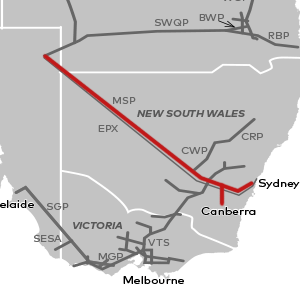The Moomba to Sydney Pipeline (MSP) is a transmission pipeline that operates across NSW. The pipeline is owned and operated by the APA Group.
The MSP mainline (Moomba to Wilton) is 1300 km in length, a nominal diameter of DN 850, a forward-haul capacity of 565 TJ/day and a back-haul capacity of 193 TJ/day. The pipeline links the Cooper basin gas fields at Moomba in South Australia to gas distribution systems in Sydney, Newcastle, Wollongong, Canberra and some NSW regional centers. In other sections of the MSP the capacity is the following: Young to Culcairn (195 TJ/d) and Culcairn to Young (200 TJ/day).
Some parts of the pipeline vary in diameter as follows:
- Dalton to Canberra - 57.9km, DN250
- Young to Lithgow - 212.5km, DN150
- Bathurst Spur - 2.2km, DN100
- Browns Creek to Orange - 23.9km, DN100
- Brewongle to Oberon - 30.9km, DN150
- Young to Wagga Wagga - 131km, DN300
- Wagga to Bethungra North (loop) - 61km, DN450
- Cootamundra Spur - 2.8km, DN80
- Junee to Griffith/leeton - 179km, DN150
- Junee Spur - 1.1km, DN100
- Culcarin to Wagga Wagga - 87km, DN450
- Young loop - 39km, DN450
- Bethungra loop - 31km, DN450
Since 2008, with the completion of the QSN Link which connects to the MSP at Moomba and the change in flow direction on the South West Queensland Pipeline (SWQP), gas can also be sourced from conventional and coal seam gas fields in the Bowen-Surat basin in Queensland. In December 2015, the MSP became bi-directional. A new receipt point at Wilton connected to Jemena Eastern Gas Pipeline and provided the ability to flow gas north to Moomba.
The MSP is subject to two different forms of regulation:
- The Moomba-Marsden segment of the mainline and the Wagga Wagga-Culcairn lateral are non-scheme pipelines and subject to the access regime for non-scheme pipelines under Chapter 6A of the NGL and Part 23 of the NGR.
- The Marsden-Wilton segment and the other laterals (Dalton-Canberra, Young-Lithgow-Bathurst, Young-Wagga Wagga, and Burnt Creek-Griffith) are classified as covered and subject to light regulation under the AER.
Background
The pipeline was initially subject to regulation by the ACCC as a covered pipeline under the Gas Code. It has been the subject of two coverage revocation processes and a light regulation determination.
First, in 2000 the service provider was unsuccessful in seeking revocation of coverage for most parts of the pipeline. The NCC, and then subsequently the Minister, rejected the application.
Revocation for certain parts of the MSP were subsequently sought by the service provider. In 2002 the NCC again recommended against revocation. However, the Minister’s decision was to revoke coverage of the Moomba-Marsden segment of the mainline. The remainder of the MSP was to continue to be a covered pipeline subject to full regulation with the exception of Young-Culcairn (part the Interconnect) which had not been covered.
In 2008, the NCC determined to change the form of regulation applied to the covered part of the MSP from full regulation to light regulation.
The MSP was constructed in 1976 to service the NSW gas market. It comprises a mainline from the Moomba processing plant to Wilton near Sydney and four lateral pipelines (Young to Orange and Lithgow, Young to Wagga Wagga, Junee to Griffith and Dalton to Canberra). With the completion of the NSW-Victoria Interconnect between Wagga Wagga and Culcairn in 1998, gas can be transported bi-directionally between NSW and the Victorian Transmission System. The capacity between NSW and the Victorian Transmission System has been progressively expanded between 2014 and 2017 to transport additional gas between NSW and Victoria. The MSP is also interconnected with the Central West Pipeline (CWP).
The following augmentations have been made since initial commissioning:
- 1974-1976: Mainline constructed. Nameplate capacity: 280 TJ/d
- 1986: Bulla Park compressor installed. Nameplate capacity: 397 TJ/d
- 1989: Young compressor installed. Nameplate capacity: 480 TJ/d
- 2004-2006: Derating due to stress corossion cracking. MOP Reduction.
Bulla Park series operation. Nameplate capacity: 400 TJ/d - 2008: Repairs to increase MOP Moomba - Bulla Park MOP to 5000 kPa, MW300 Regulator installed. Nameplate capacity: 420 TJ/d
- 2010: Repairs to increase MOP Moomba - Bulla Park MOP to 5200 kPa, Bulla - Young MOP 5500 kPa, Young Compressor in series. Nameplate capacity: 439 TJ/d
- 2017: VNIE loop completed. North bound flows from Culcairn increases MSP capacity. Nameplate capacity: 489 TJ/d
- 2019: Moomba Compressors Low Pressure Lift (Mars 90), Installation of Regulator at Young, Bulla Park bi-directional.
Wilton - Moomba capacity: 193 TJ/d
Culcairn - Young capacity: 200 TJ/d - 2019: SHEX1 - Young Wagga Compressor Upgrade Project.
Young - Culcairn capacity: 195 TJ/d - 2020: Nameplate capacity redeclared: 446 TJ/d based on south bound flows from Moomba.
- 2023: 1x Mars -100 at MW880. Nameplate capacity: 475 TJ/d
- 2024: 1x Mars-100 at MW433. Nameplate capacity: 565 TJ/d
